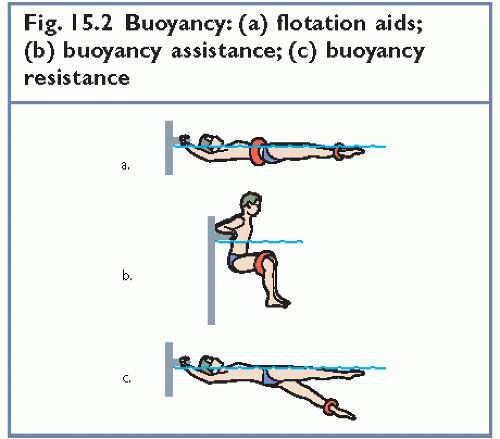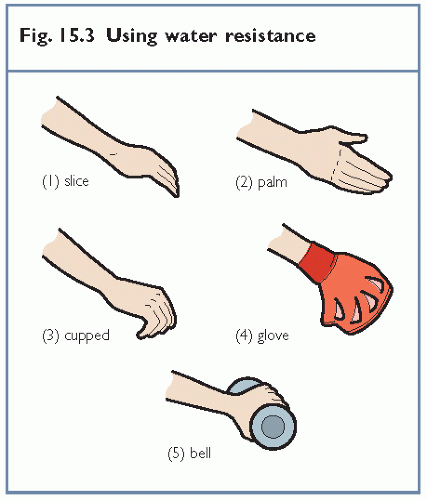Abdominal Training in the Pool
Water has a number of advantages for any exercise involving the spine. The warmth of water is soothing, making it very useful following back pain. In addition, water will support the body, taking some of the bodyweight off the joints and spine and so will reduce pain. The muscles responsible for maintaining posture need to work less in water as well because your posture is supported by the water itself.
For the elderly, who may have circulatory problems as well as back pain, water has a further advantage. The pressure variation from the bottom of the pool to the surface actually helps the blood to return to the heart from the legs (venous return) and so reduces ‘tired legs’. Furthermore, the pressure changes created by the depth of the water assist in the reduction in blood pooling (blue veins in the legs) and swelling around the ankles.
Keypoint
Pressure variation from the bottom of a pool to the top aids venous return, a feature especially important in those individuals with poor circulation in their legs.
Principles of water exercise
Buoyancy
Buoyancy is the degree to which your body will float when it is in water. Your individual buoyancy is determined by your body makeup. Body fat will make you more buoyant, while muscle makes you less. Plump individuals will tend to float, therefore, while those who are skinny are more likely to sink.
The distribution of your body fat is also important. Those with more fat around the waist and lower body (pear shape) will find that their legs float more while leaner individuals find their legs sink. This is why, in general, men float deeper in the water than women. If you do float lower in the water, you may find some of the exercises easier if you use floats.
The depth of the water you are standing in will also affect your buoyancy. The body will float more when it is in deeper water. When the water is waist high, your bodyweight is
actually reduced by about 50 per cent. When the water is up to your shoulders, your bodyweight is effectively reduced by 90 per cent, so there is considerably less shock on the joints and spine in deeper water. This is what makes deep water training so effective at maintaining CV fitness without jolting the spine and leg joints. However, because you float more in deeper water, movement can be harder to control, so be cautious.
actually reduced by about 50 per cent. When the water is up to your shoulders, your bodyweight is effectively reduced by 90 per cent, so there is considerably less shock on the joints and spine in deeper water. This is what makes deep water training so effective at maintaining CV fitness without jolting the spine and leg joints. However, because you float more in deeper water, movement can be harder to control, so be cautious.
Keypoint
Buoyancy is related to body density. Thinner and more muscular individuals tend to sink, while those with higher body fat will float.
Buoyancy can be used to support parts of the body, and both to assist and resist movements. In fig. 15.2a, the subject is lying flat in the water, holding on to the siderail of the swimming pool. To enable him to float he has placed a rubber ring around his waist, and a smaller ring around his legs. The rings can be inflated or deflated according to the subject’s buoyancy, to allow the body to float either just beneath the surface of the water or deeper. This supported lying position enables a selection of spinal exercises to be performed with the body moving freely in several directions.
In fig. 15.2b, buoyancy is being used for assistance. The subject is performing a knee lift movement, but the legs are too heavy to perform the movement correctly. A ring has been placed around the knees to allow the legs to float partially, in effect making them lighter and assisting the upward action of the legs. In fig. 15.2c, the reverse situation is occurring. The exercise is hip extension, pressing the leg downwards. Now, the buoyancy of the rubber ring tending to lift the leg upwards is acting as a resistance to the downwards movement of the leg.
Keypoint
Buoyancy can be used to assist or resist a movement, and to support a body part during exercise.
Resistance
Resistance is also provided by the movement of an object through water. The greater the amount of water which has to move, and the faster the object moves, the greater the resistance. Placing the hand side-on (see fig. 15.3 (2)) and moving it slowly through the water provides a certain resistance to the arm muscles performing the movement. If the hand is turned through 90 degrees so that it faces vertically (see fig. 15.3 (1)), it provides considerably more resistance to movement and so the arm muscles must work harder. Speeding up the movement increases the workload still further.
To boost muscle work further we can use apparatus to increase resistance (see fig. 15.3 (4 and 5)). Floats placed on their sides and webbed hand gloves are both useful to enhance a water workout.
Other water apparatus is also useful to offer variety in exercises including aquatubes (woggles), steps, plastic dumbbells (see fig. 15.3 (5)), and a buoyancy aid for deep water training.
Because fast movements offer greater resistance, rapid limb movements are useful when working on trunk stability. Standing in deep water and pushing a float rapidly forwards and backwards, for example, will tend to displace the trunk. Tightening the abdominal muscles against this displacement will enhance trunk stability.
Keypoint
Less streamlined objects offer greater water resistance, and can be used to make an exercise harder.
Safety considerations
Obviously water is a dangerous medium to work in, but these dangers can be considerably reduced by taking sensible precautions. Poor swimmers should never practise water exercises in water above waist height, and they must stay close to the poolside at all times. Young children must be continuously supervised, however strong their swimming may appear.
Stay updated, free articles. Join our Telegram channel

Full access? Get Clinical Tree











